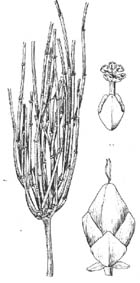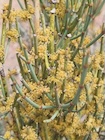Ephedra intermedia
Schrenk & C.A. Meyer ex C.A. Meyer 1846
Common names
中麻黄 zhong ma huang [Chinese] (Fu et al. 1999).
Taxonomic notes
Synonymy: Many names, see POWO for a full list, except that I add E. glauca Regel to the list, in accordance with Fu et al. (1999). The hybrid with E. strobilacea is Ephedra × eleutherolepis V.A. Nikitin 1966, and has only been reported from Tadzhikistan.
Description
Shrubs up to 1 m tall, densely branched, erect to spreading or sometimes with a creeping stem producing single, erect, green primary branches. Branchlets yellowish or bluish green, often pruinose, internodes usually 2-6 cm × 1.5-3.5 mm, straight or slightly bent. Leaves in whorls of 3 or opposite, connate for at least 2/3 their length. Pollen cones up to 8, whorled, usually clustered at nodes, often sessile; bracts in 3 or 4 pairs or whorls; anthers 5-8, sessile or shortly stipitate; staminate column slightly exserted. Seed cones ellipsoid, ovoid, or oblong-ovoid; bracts in 2-5 pairs or whorls, outer ones connate at base, apical pair or whorl connate for ca. 1/2 their length, margins membranous, globose, red, and fleshy at maturity; integument tube long, 3-5 mm, usually spirally twisted. Berry ovoid, red. Seeds 2 or 3, ovoid or elongate-ovoid, 5-6 × ca. 3 mm, brownish, concealed by bracts. Pollination May-Jun, seed maturity Jul-Aug. 2n = 14, 28 (Ali and Qaiser 1987, Fu et al. 1999). See also the description in Bobrov (1968).
Distribution and Ecology
Afghanistan; Kazakstan; Kyrgyzstan; Mongolia; Pakistan; Russia; Tajikistan; Turkmenistan; Uzbekistan; SW Asia; China: Gansu, Hebei, Liaoning, Nei Mongol, Ningxia, Qinghai, Shaanxi, Shandong, Shanxi, Xinjiang, and Xizang. Found at (100-)800-4600 m elevation in grasslands, deserts, river valleys, floodplains, sandy beaches, cliffs, and other dry, sandy or rocky places (Fu et al. 1999).
Remarkable Specimens
No data as of 2023.03.03.
Ethnobotany
"This species has medicinal properties" (Fu et al. 1999).
Observations
See the observations on iNaturalist, accessed 2021.12.30.
Remarks
The epithet refers to the plant's appearance as intermediate between "E. helveticam et E. monospermum" (now known as E. distachya subsp. helvetica and E. monosperma) (Meyer 1846).
Citations
Ali, S.I. and M. Qaiser (eds.). 1987. Flora of Pakistan. http://www.efloras.org.
Bobrov, E. G. 1968. Ephedraceae, pp. 154-160 in V.L. Komarov (ed.), Flora of the USSR, Vol. 1, trans. by the Israel Program for Scientific Translations. Washington DC: Smithsonian Institution and National Science Foundation. Available: Biodiversity Heritage Library, accessed 2021.12.29.
Nikitin, V.A. 1966. Novosti Sist. Vyssh. Rast. 1966:5.
Meyer, C. A. 1846. Versuch einer Monographie der Gattung Ephedra, Durch Abbildungen Erlautert. Mémoires de l'Académie impériale des sciences de St.-Pétersbourg, Sér. 6, Sci. Math., Seconde Pt. Sci. Nat. 5:88. Available: Biodiversity Heritage Library, accessed 2021.12.31.
See also
Species profile at Plants of the World Online, accessed 2021.12.30.




